Older Driver Highway Design Handbook
I. INTERSECTIONS (AT-GRADE)
- Intersecting Angle (Skew)
- Receiving Lane (Throat) Width for Turning Operations
- Channelization
- Intersection Sight Distance (Sight Triangle)
- Opposite (Single) Left-Turn Lane Geometry, Signing, and Delineation
- Edge Treatments/Delineation of Curbs, Medians, and Obstacles
- Curb Radius
- Traffic Control for Left-Turn Movements at Signalized Intersections
- Traffic Control for Right-Turn/RTOR Movements at Signalized Intersections
- Street-Name Signage
- One-Way/Wrong-Way Signage
- Stop- and Yield-Controlled Intersection Signage
- Devices for Lane Assignment on Intersection Approach
- Traffic Signal Performance Issues
- Fixed Lighting Installations
- Pedestrian Control Devices
Background and Scope of Handbook Recommendations
The single greatest concern in accommodating older road users, both drivers and pedestrians, is the ability of these persons to safely maneuver through intersections. The findings
of one widely cited analysis of nationwide accident data (Hauer, 1988), illustrated below, reveal the relationship between injuries and fatalities at intersections during the period 19831985 in the
United States, as a function of age and road user type (driver or pedestrian).

For drivers 80 years and older, more than half of fatal accidents occur at intersections, compared
with 24 percent or less for drivers up to 50 years of age (Insurance Institute for Highway Safety,
1993). These findings reinforce a long-standing recognition that driving situations involving
complex speed-distance judgments under time constraints—the typical scenario for intersection
operations—are more problematic for older drivers and pedestrians than for their younger
counterparts (Waller, House, and Stewart, 1977). Other studies within the large body of evidence
showing dramatic increases in intersection accident involvements as driver age increases have
revealed detailed patterns of data associating specific accident types and vehicle movements with
particular age groups, and in some cases have linked such patterns to the driving task demands in a
given maneuver situation (see Campbell, 1993; Council and Zegeer, 1992; Staplin and Lyles, 1991).
Another approach to characterizing older driver problems at intersections was employed by
Brainin (1980), who used in-car observations of driving behavior with 17 drivers ages 2544, 81
drivers ages 6069, and 18 drivers age 70 and older, on a standardized test route. The two older
age groups showed more difficulty making right and left turns at intersections and negotiating
traffic signals. The left-turn problems resulted from a lack of sufficient caution and poor
positioning on the road during the turn. Right-turn difficulties were primarily a result of failing to
signal. Errors demonstrated at STOP signs included failing to make complete stops, poor vehicle
positioning at STOP signs, and jerky and abrupt stops. Errors demonstrated at traffic signals
included stops that were either jerky and abrupt, failure to stop when required, and failure to show
sufficient caution during the intersection approach.
Complementing accident analyses and observational studies with subjective reports of
intersection driving difficulties, a statewide survey of 664 senior drivers by Benekohal, Resende,
Shim, Michaels, and Weeks (1992) found that the following activities become more difficult for
drivers as they grow older (with proportion of drivers responding in parentheses):
- Reading street signs in town (27 percent).
- Driving across an intersection (21 percent).
- Finding the beginning of a left-turn lane at an intersection (20 percent).
- Making a left turn at an intersection (19 percent).
- Following pavement markings (17 percent).
- Responding to traffic signals (12 percent).
Benekohal et al. (1992) also found that the following highway features become more important to drivers as they age (with proportion of drivers responding in parentheses):
- Lighting at intersections (62 percent).
- Pavement markings at intersections (57 percent).
- Number of left-turn lanes at an intersection (55 percent).
- Width of travel lanes (51 percent).
- Concrete lane guides (raised channelization) for turns at intersections (47 percent).
- Size of traffic signals at intersections (42 percent).
Comparisons of responses from drivers ages 6668 versus those age 77 and older showed that the older group had more difficulty following pavement markings, finding the beginning of the left-turn lane, and driving across intersections. Similarly, the level of difficulty for reading street signs and making left turns at intersections increased with increasing senior driver age. Turning left at intersections was perceived as a complex driving task. This was made more difficult when raised channelization providing visual cues was absent, and only pavement markings designated which were through lanes versus turning lanes ahead. For the oldest age group, pavement markings at intersections were the most important item, followed by the number of left-turn lanes, concrete guides, and intersection lighting. A study of older road users completed in 1996 provides evidence that the single most challenging aspect of intersection negotiation for this group is performing left turns during the permitted (green ball) signal phase
(Staplin, Harkey, Lococo, and Tarawneh, 1997).
During focus group discussions conducted by Benekohal et al. (1992), older drivers
reported that intersections with too many islands are confusing, that raised curbs that are unpainted are difficult to see, and that textured pavements (rumble strips) are of value as a warning of upcoming raised medians, approaches to (hidden or flashing red) signals, and the roadway edge/shoulder lane boundary. Regarding traffic signals, study subjects indicated a clear preference to turn left on a protected arrow phase, rather than making "permitted phase" turns. When turning during a permitted phase (green ball) signal operation, they reported waiting for a large gap before making a turn, which frustrates drivers in back of them and causes the drivers behind to go around them or blow their horns. A general finding here was the need for more time to react.
Additional insight into the problems older drivers experience at intersections was provided
by focus group responses from 81 older drivers in the Staplin et al. study (1997). The most
commonly reported problems are listed below:
- Difficulty in turning head at skewed (non-90-degree) angles to view intersecting traffic.
- Difficulty in smoothly performing turning movements at tight corners.
- Hitting raised concrete barriers such as channelizing islands in the rain and at night due to poor visibility.
- Finding oneself positioned in the wrong lane—especially a "turn only" lane—during an intersection approach, due to poor visibility (maintenance) of pavement markings or the obstruction of roadside signs designed to inform drivers of intersection traffic patterns.
- Difficulty at the end of an auxiliary (right)-turn lane in seeing potential conflicts well and quickly enough to smoothly merge with adjacent-lane traffic.
- Merging with adjacent-lane traffic after crossing an intersection, when a lane drop occurs near the intersection (e.g., when two lanes merge into one lane within 150 m [500 ft] after crossing the intersection).
Although these problems are by no means unique to older drivers, the various functional deficits associated with aging result in exaggerated levels of difficulty for this user group.
Finally, the analysis by Council and Zegeer (1992) included an examination of pedestrian accidents and the collision types in which older pedestrians were overinvolved. The results
showed older pedestrians to be overrepresented in both right- and left-turn accidents. The young-elderly (ages 6574) were most likely to be struck by a vehicle turning right, whereas the old-elderly (age 75 and older) were more likely to be struck by a left-turning vehicle.
This section will provide recommendations to enhance the performance of diminished-capacity drivers as they approach and travel through intersections, for 16 different design elements:
A. intersecting angle (skew); B. receiving lane (throat) width for turning operations; C. channelization; D. intersection sight distance (sight triangle); E. opposite (single) left-turn lane geometry, signing, and delineation; F. edge treatments/delineation of curbs, medians, and obstacles; G. curb radius; H. traffic control for left-turn movements at signalized intersections; I. traffic control for right-turn/right-turn-on-red (RTOR) movements at signalized intersections; J. street-name signage; K. one-way/wrong-way signage; L. stop- and yield-controlled intersection signage; M. devices for lane assignment on intersection approach; N. traffic signal performance issues; O. fixed lighting installations; and P. pedestrian control devices.
The Handbook recommendations that follow are supported by material presented later in
the "Rationale and Supporting Evidence" section under the "Intersections (At-Grade)" heading.
Recommendations by Design Element
A. Design Element: Intersecting Angle (Skew)
- In the design of new facilities where right-of-way is not restricted, all intersecting roadways should meet at a 90-degree angle.
In the design of new facilities or redesign of existing facilities where right-of-way is restricted, intersecting roadways should meet at an angle of not less than 75 degrees.
The rationale and supporting evidence for these recommendations can be found by clicking here.
 back to top back to top
B.
Design Element: Receiving Lane (Throat) Width for Turning Operations
- A minimum receiving lane width of 3.6 m (12 ft) is recommended, accompanied, wherever practical, by a shoulder of 1.2 m (4 ft) minimum width.
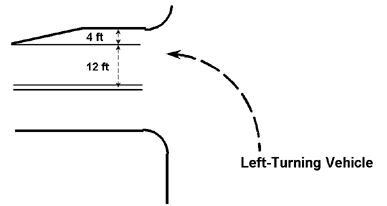
The rationale and supporting evidence for this recommendation can be found by clicking here.
 back to top
back to top
C.
Design Element: Channelization
- At intersections with a high volume of pedestrians, it is recommended that right-turn channelization not be implemented without the provision of an adjacent pedestrian refuge island conforming to MUTCD (Federal Highway Administration, 1988) and AASHTO (1994) specifications.
If right-turn channelization is present at an intersection, an acceleration lane providing for the acceleration characteristics of passenger cars as delineated in AASHTO specifications (1994) is recommended.
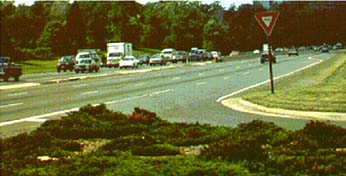
Raised channelization (sloping curbed medians) is recommended over painted channelization for left- and right-turn lane treatments at intersections, with island curb sides and curb surfaces treated with reflectorized paint and maintained at a minimum luminance contrast level of 3.0 or higher under low beam (passenger vehicle) headlight illumination.
The rationale and supporting evidence for these recommendations can be found by clicking here.
 back to top back to top
D. Design Element: Intersection Sight Distance (Sight Triangle)
- For Cases I through IV, as described below, it is recommended that perception-reaction time (PRT) for intersection sight distance (ISD) be no less than 2.5 s to accommodate the slower decision times exhibited
by, and the larger gap sizes desired, by older drivers.
Case I: No Control
Case II: Yield Control
Case IIIA: Stop Control—Crossing
Case IIIB: Stop Control—Left Turn
Case IIIC: Stop Control—Right Turn
Case IV: Signal Control
- For ISD Case V (Stop Control—Vehicle Turning Left From Major Highway), unrestricted sight distances and corresponding left-turn lane offsets are recommended whenever possible in the design of opposite left-turn lanes at intersections.
2a. At intersections where there are large percentages of left-turning trucks, the offsets required to provide unrestricted sight distance for opposing left-turn trucks should be used.
2b. Where the provision of unrestricted sight distance is not feasible, ISD values for left-turning traffic that must yield to opposing traffic on the major roadway (ISD Case V) should be computed using the modified AASHTO model, as follows:
| ISD = 1.47 V (J +ta) |
English |
| ISD = 0.278 V (J +ta) |
Metric |
where: ISD = intersection sight distance (feet for English equation; meters for metric equation).
V = major roadway operating speed (mi/h for English equation; km/h for metric equation).
J = time to search for oncoming vehicles, to perceive that there is sufficient time to make the left turn, and to shift gears, if necessary, prior to starting (modified to 2.5 s).
ta = time required to accelerate and traverse the distance to clear traffic in the approaching lane(s); obtained from figure IX-33 in the AASHTO Green Book.
The rationale and supporting evidence for these recommendations can be found by clicking here.
 back to top back to top
E.
Design Element: Opposite (Single) Left-Turn Lane Geometry, Signing, and Delineation
- Unrestricted sight distance (achieved through positive offset of opposite left-turn lanes) is recommended whenever possible, for new or reconstructed facilities. This will provide a margin of safety for older drivers who, as a group, do not position themselves within the intersection before initiating a left turn.

At intersections where engineering judgment indicates a high probability of heavy trucks as the opposing turn vehicles during normal operations, the offsets required to provide unrestricted sight distance for opposing left-turn trucks should be used, for new or reconstructed facilities.

Where the provision of unrestricted sight distance is not feasible, ISD values for left-turning traffic that must yield to opposing traffic on the major roadway (ISD Case V) should be computed using the modified AASHTO model, as follows:
ISD = 1.47 V (J +ta) English English
ISD = 0.278 V (J +ta) Metric Metric
where: ISD = intersection sight distance (feet for English equation; meters for metric equation).
V = major roadway operating speed (mi/h for English equation; km/h for metric equation).
J = time to search for oncoming vehicles, to perceive that there is sufficient time to make the left turn, and to shift gears, if necessary, prior to starting (modified to 2.5 s).
ta = time required to accelerate and traverse the distance to clear traffic in the approaching lane(s); obtained from Figure IX-33 in the AASHTO Green Book (1994).
At intersections where the left-turn lane treatment results in channelized offset left-turn lanes (e.g., a parallel or tapered left-turn lane between two medians) the following countermeasures are recommended to reduce the potential for wrong-way maneuvers by drivers turning left from a stop-controlled, intersecting minor roadway:
4a. In the implementation of (advance) DIVIDED HIGHWAY CROSSING signs, and WRONG WAY, DO NOT ENTER, and ONE WAY signs at the intersection, as per MUTCD (Federal Highway Administration, 1988) specifications, sign sizes larger than MUTCD standard sizes (e.g., MUTCD expressway size for DO NOT ENTER [900 x 900 mm] and MUTCD special size for WRONG WAY [1050 x 750 mm]) are recommended, as is high-intensity sheeting.
4b. Lane-use arrows for channelized left-turn lanes are recommended, and reflectorized treatments should be used wherever practical; otherwise, white painted pavement markings should be used.
4c. Pavement markings which scribe a path through the turn are recommended to reduce the likelihood for the wrong-way movement.
4d. The use of a white stop bar 600 mm (24 in) in width is recommended at the end of the channelized left-turn lane as a countermeasure to aid in preventing a potential wrong-way movement.
4e. Placement of 7-m (23.5-ft) wrong-way arrows in the through lanes is recommended for wrong-way traffic control at locations determined to have a special need, as specified in the MUTCD, section 2E-40.
4f. Delineation of median noses using reflectorized paint and other treatments to increase their visibility and improve driver understanding of the intersection design and function is recommended.
The diagram presented on the facing page illustrates the countermeasures as described above in Handbook Recommendations E(4a)(4f).
The rationale and supporting evidence for these recommendations can be found by clicking here.

Recommended signing and delineation treatments for intersections with medians 9 m (30 ft) wide or wider, and medians with channelized left-turn lanes, to reduce the potential for wrong-way movements for drivers turning left from the minor roadway.
 back to top back to top
F. Design Element: Edge Treatments/Delineation of Curbs, Medians, and Obstacles
A minimum in-service contrast level of 2.0 is recommended between the painted edge of the roadway and the road surface for intersections with overhead lighting, where:

- A minimum in-service contrast level of 3.0 is recommended between
the painted edge of the roadway and the road surface for intersections without overhead lighting.
- It is recommended that all curbs at intersections (including median islands and other raised channelization) be delineated on their vertical face and at least a portion of the top surface, in addition to the provision of a painted edgeline on the road surface.
It is recommended that a "preview" of vertical surfaces be provided using cross-hatched pavement markings, as specified in the MUTCD (Federal Highway Administration, 1988), section 3B-13.
The rationale and supporting evidence for these recommendations can be found by clicking here.
 back to top back to top
G. Design Element: Curb Radius
Except where precluded by high volumes of heavy vehicles, a corner curb radius of 9 m (30 ft) is recommended as a tradeoff to (a) facilitate vehicle turning movements, (b) moderate the speed of turning vehicles, and (c) avoid unnecessary lengthening of pedestrian crossing distances.
The rationale and supporting evidence for these recommendations can be found by clicking here.
 back to top back to top
H. Design Element: Traffic Control for Left-Turn Movements at Signalized Intersections
The use of protected-only operations is recommended, except when, based on engineering judgment, an unacceptable reduction in capacity will result.
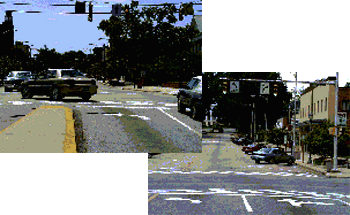
To reduce confusion during an intersection approach, the use of a separate signal to control movements in each lane of traffic is recommended.
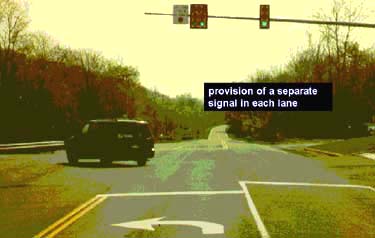
- Consistent use of a common sign throughout the United States advising drivers of the correct response to a steady green ball during protected-permitted operations (R10-12, "LEFT TURN YIELD ON GREEN") is recommended, with overhead placement preferred at the intersection.
- A leading protected left-turn phase is recommended wherever protected left-turn signal operation is implemented.
- To reduce confusion about the meaning of the red arrow indication, it is recommended that the steady green arrow for protected-only left-turn operations terminate to a yellow arrow, then a steady red ball.
- The use of redundant upstream signing (R10-12) is recommended to advise left-turning drivers of permitted signal operation. It is also recommended that the signing afford at least a 3-s preview (at operating speeds in the left turn lane) before the intersection, using either overhead or median sign placement.
- Where the required (minimum) sight distance as calculated using a modified AASHTO intersection sight distance (ISD) model with a 2.5-s perception-reaction time (PRT) (see Handbook Chapter I, Design Element E) is not practical to achieve through geometric redesign/reconstruction, the following operational changes are recommended:
7a. If programmable signal control capability exists, restrict permitted left-turn operations to low-volume (off-peak) conditions.
7b. Where a pattern of permitted left-turn accidents occurs, eliminate permitted left turns and implement protected-only left-turn operations.
The rationale and supporting evidence for these recommendations can be found by clicking
here.
 back to top back to top
I.
Design Element: Traffic Control for Right-Turn/RTOR Movements at Signalized Intersections
- To reduce confusion with the meaning of the (right-turn) red arrow, it is recommended that a steady red ball be used at signalized intersections
where a right turn is prohibited, supplemented by the NO TURN ON RED sign depicted in Recommendation 3 below.
- The prohibition of right turn on red (RTOR) at skewed intersections (angle less than 75 degrees or greater than 105 degrees) is recommended.
- The signing of prohibited RTOR movements using the novel design (as shown) is recommended, with sign placement on the overhead mast arm
and on the opposite corner of the intersection.
 Where RTOR is permitted and a pedestrian crosswalk is delineated on the intersecting roadway, the posting of signs with the legend TURNING TRAFFIC MUST YIELD TO PEDESTRIANS is recommended, in an overhead or roadside location that is easily visible to the motorist prior to initiating the turning maneuver. Where RTOR is permitted and a pedestrian crosswalk is delineated on the intersecting roadway, the posting of signs with the legend TURNING TRAFFIC MUST YIELD TO PEDESTRIANS is recommended, in an overhead or roadside location that is easily visible to the motorist prior to initiating the turning maneuver.
The rationale and supporting evidence for these recommendations can be found by clicking here.
 back to top back to top
J. Design Element: Street-Name Signage
- To accommodate the reduction in visual acuity associated with increasing age, a minimum letter height of 150 mm (6 in) is recommended for use on post-mounted street-name signs (D3).
- The use of overhead-mounted street-name signs with minimum letter heights of 200 mm (8 in) is recommended at major intersections.
Wherever an advance intersection warning sign is erected (e.g., W2-1, W2-2, W2-3, W2-4), it is recommended that it be accompanied by a supplemental street-name sign.

The use of redundant street-name signing for major intersections is recommended, with an advance street-name sign placed upstream of the intersection at a midblock location, and an overhead-mounted street-name sign posted at the intersection. Wherever practical, the midblock sign should be mounted overhead.

- When different street names are used for different directions of travel on a crossroad, the names should be separated and accompanied by directional arrows on both midblock and intersection street-name signs, as shown below:

The rationale and supporting evidence for these recommendations can be found by clicking
here.
 back to top
back to top
K. Design Element: One-Way/Wrong-Way Signage
- It is recommended that approaches to divided highways be consistently signed; use of the DIVIDED HIGHWAY CROSSING sign (R6-3) is the recommended
current practice, but this sign may be replaced or supplemented with new treatments that are demonstrated through research to provide improved comprehensibility to motorists.
- For divided highways with medians of 9 m (30 ft) and under, the use of four ONE WAY signs is recommended, as shown in the configuration
diagrammed below.

Recommended signing configuration for medians less than or equal to 9 m (30 ft).
- For medians over 9 m (30 ft), the use of eight ONE WAY signs is recommended, as diagrammed in Recommendation 4 of Design Element E.
- For T-intersections, the use of a near-right side ONE WAY sign and a far side ONE WAY sign is recommended; the preferred placement for the far side sign is opposite the extended centerline of the approach leg as shown in MUTCD figure 2-4 (Federal Highway Administration, 1988). Where the preferred far side location is not feasible because of blockage, distracting far side land use, or an excessively wide approach leg, etc., engineering judgment should be applied to select the most conspicuous alternate location for a driver who has not yet initiated the wrong-way turning maneuver.
- For four-way intersections (i.e., the intersection of a one-way street with a two-way street), ONE WAY signs placed at the near right/far left locations are recommended, regardless of whether there is left-to-right or right-to-left traffic.
As a general practice, the use of DO NOT ENTER and WRONG WAY signs is recommended at locations where the median width is 6 m (20 ft) and greater; consideration should also be given to the use of these signs for median widths narrower than 6 m (20 ft), where engineering judgment indicates a special need.
The rationale and supporting evidence for these recommendations can be found by clicking here.
 back to top
back to top
L. Design Element: Stop- and Yield-Controlled Intersection Signage
System-wide recommendations* to improve the safe use of intersections by older drivers, where the need for stop control or yield control has already been determined, include the following:
- The use of standard size (750 mm [30 in]) STOP (R1-1) and standard size (900 mm [36 in]) YIELD (R1-2) signs, as a minimum, is recommended wherever these devices are implemented.
- A minimum in-service sign background (red area) retroreflectivity level of 12 cd/m2/lux for roads with operating speeds under 64 km/h (40 mi/h), and 24 cd/m2/lux for roads with operating speeds of 64 km/h (40 mi/h) or higher, is recommended for STOP (R1-1) and YIELD (R1-2) signs.
- The use of a supplemental warning sign panel mounted below the STOP (R1-1) sign, as illustrated, is recommended for two-way stop-controlled intersection sites selected on the basis of accident experience; where the sight triangle is restricted; and wherever a conversion from four-way stop to two-way stop operations is implemented.

- It is recommended that a STOP AHEAD sign (W3-1a) be used where the distance at which the STOP sign is visible is less than the AASHTO stopping sight distance (SSD) at the operating speed, plus an added preview distance of at least 2.5 s. Consideration should also be given to the use of transverse pavement striping or rumble strips upstream of stop-controlled
intersections where engineering judgment indicates a special need due to sight restrictions, high approach speeds, or other geometric or operational characteristics likely to violate driver expectancy.
*It is recognized that these broad recommendations may not address all of the diverse and varying problems occurring at any unique location, resulting in the need for engineering study to identify specific additional measures or combinations of measures to modify problem driver behaviors.
The rationale and supporting evidence for these recommendations can be found by clicking here.
 back to top back to top
M.
Design Element: Devices for Lane Assignment on Intersection Approach
- The consistent placement of lane-use control signs (R3-5, R3-6) overhead on the signal mast arm at intersections is recommended, as a supplement to pavement markings and shoulder- and/or median-mounted signage.

The consistent posting of lane-use control signs plus application of lane-use arrow pavement markings at a preview distance of at least 5 s (at operating speed) in advance of a signalized intersection is recommended, regardless of the specific lighting, channelization, or delineation treatments implemented at the intersection. Signs should be mounted overhead wherever practical, but they may be shoulder- and/or median-mounted in other cases.
The rationale and supporting evidence for these recommendations can be found by clicking here.
 back to top
back to top
N. Design Element: Traffic Signal Performance Issues
- To accommodate the increased optical density (reduced ocular transmittance) of the older driver's eye, and to improve availability of signal information under divided attention conditions during an intersection approach, it is recommended for all over-the-road signals that the Commission Internationale de l'Éclairage (CIE) 1980 standard for vertical intensity distribution (percent of peak) for a 300-mm (12-in) signal be adhered to in the United States, as given below:
Vertical Angle
(degrees) |
Intensity (% of Peak) |
| Backplate |
No Backplate |
| 01.5 |
100 |
100 |
| 1.52.0 |
67 |
95 |
| 2.03.0 |
33 |
90 |
| 3.04.0 |
25 |
80 |
| 4.05.0 |
17 |
60 |
| 5.010.0 |
8 |
30 |
|---|
To accommodate age differences in perception-reaction time (PRT), it is recommended that an all-red clearance interval be consistently implemented, with length determined according to the Institute of Transportation Engineers (1992) expressions given below.
When there is no pedestrian traffic, use:

Where there is the probability of pedestrian crossings, use the greater of:

or

Where there is significant pedestrian traffic or pedestrian signals to protect the crosswalk, use:

where: r = length of red clearance interval, to the nearest 0.1 s.
W = width of intersection (ft or m), measured from the near-side stop line to the far edge of the conflicting traffic lane along the actual vehicle path.
P = width of intersection (ft or m), measured from the near-side stop line to the far side of the farthest conflicting pedestrian crosswalk along the actual vehicle path.
L = length of vehicle, recommended as 20 ft or 6.1 m.
V = speed of the vehicle through the intersection (ft/s). Wherever practical, the use of a backplate with traffic signals on roads with operating speeds of 64 km/h (40 mi/h) or less is recommended.
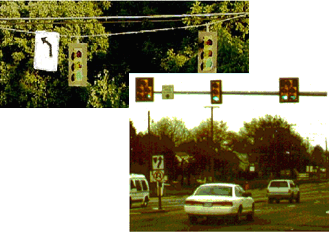
The consistent use of a backplate with traffic signals on roads with operating speeds over 64 km/h (40 mi/h) is recommended.
The rationale and supporting evidence for these recommendations can be found by clicking here.
 back to top back to top
O.
Design Element: Fixed Lighting Installations
- Wherever feasible, fixed lighting installations are recommended (a) where the potential for wrong-way movements is indicated through accident experience or engineering judgment; (b) where pedestrian volumes are high; or (c) where shifting lane alignment, turn-only lane assignment, or a pavement-width transition forces a path-following adjustment at or near the intersection.
Regular cleaning of lamp lenses and lamp replacement when output has degraded by 20 percent or more of peak performance (based on hours of service and manufacturer's specifications) are recommended for all fixed lighting installations at intersections.
The rationale and supporting evidence for these recommendations can be found by clicking here.
 back to top back to top
P. Design Element: Pedestrian Control Devices
To accommodate the shorter stride and slower gait of less capable (15th percentile) older pedestrians, and their exaggerated "start-up" time before leaving the curb, pedestrian control signal timing based on an assumed walking speed of 0.85 m/s (2.8 ft/s) is recommended.
It is recommended that a placard explaining pedestrian control signal operations and presenting a warning to watch for turning vehicles be posted at the near corner of all intersections with a pedestrian crosswalk, using the design shown.

It is recommended that at intersections where pedestrians cross in two stages using a median refuge island, the placard depicted in Recommendation P(2) be placed on the median refuge island, and that a placard modified as shown be placed on the near corner of the crosswalk.

The rationale and supporting evidence for these recommendations can be found by clicking here.
 back to top back to top
Previous | Table of Contents | Next
|
